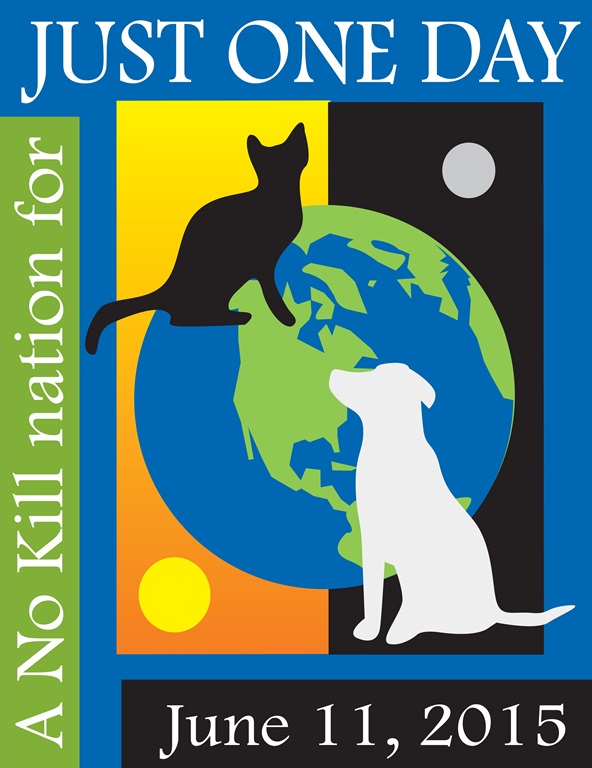
Just One Day is a campaign that asks shelters to stop killing on June 11 of every year, the anniversary of the achievement of No Kill in Tompkins County, New York – at the time, the only community in America saving all healthy and treatable dogs and cats, including all feral or community cats, rabbits, hamsters, rats, gerbils, chickens, horses, and every other species of animal who entered the shelter without limitation. In its inaugural year, some 10,000 animals were saved. Today, they save even more. June 11 may be the safest day in U.S. sheltering.
Just One Day was started by Mike Fry, a No Kill shelter director who transformed his community through the programs and services of the No Kill Equation. As a shelter director with one of the highest save rates in the country, his own positive experiences had taught him that they key to ending shelter killing was harnessing the public’s compassion through programs like foster care, partnering with rescue groups, promoting animals for adoption, and more. By contrast, shelter directors mired in killing vilified the public, calling them “irresponsible” and refusing to work with them. How to overcome this resistance, he wondered? How to get shelter directors to see the hidden potential so that, going forward, they would be motivated to embrace it? His answer: take it one day at a time.
As Fry explains,
“Killing was often such an automatic, go-to ‘solution’ for many shelters that it was … difficult for some shelters to stop: [A] lightbulb went off in my head: what better way to encourage shelters to try a new way of being than to make it one, easy, simple request. To participate, shelters don’t have to agree to a complete, dramatic overhaul of their operations. They only need to agree to try something new for Just One Day. Naturally, our goal is to have them experience a new way of operating that will set them on a new path long past June 11. Because, the fact of the matter is that if they are successful with adoptions on June 11, they shouldn’t…kill any healthy or treatable pets on June 12, and then June 13… they just need to take it one day at a time.”
And the results have been dramatic. One shelter with high rates of killing stayed open for 11 hours. Roughly 100 animals found homes, one every seven minutes the shelter was open, its most successful adoption day ever. Another shelter opened on a day it was normally closed and placed 231 animals as a result. In still another, the director of animal control who once said that he would not hesitate to kill every community cat in the world, reported that by 4:30 pm, 47 animals had been adopted. By 6:30 pm, the number was uncertain as the shelter’s computer system could not update quickly enough to keep up with adoptions. “An exceptional turnout,” said the director. “The parking lot has been full since 10:00 this morning, it continues to be full. I’ve never seen so many people come out here all at one time, in one day.” In an Arizona animal control shelter, 88 out of 100 dogs and 28 out of 30 cats were adopted by 11 am. In another community, they ran out of animals. Yet another reported staff crying: they had never seen so many animals going out the front door in the loving arms of families. For many of these shelters, it was a watershed moment. Not just because animals who would have normally been killed were saved, but because of the valuable lessons hundreds of traditional shelters across the country learned.
Indeed, one of the primary goals of the Just One Day campaign is to not only save animals through adoption on June 11, it is to get shelters resistant to the principles of the No Kill philosophy—of marketing animals, of asking the public for help, of being open for adoptions at times that are more convenient for the working public and families, of using the media to save lives and of partnering with rescue groups—to commit to trying these ways of operating. When they see the great potential afforded by these innovations, the hope is that many of them will continue to do those things not just on June 11, but on June 12, June 13, June 14, and well beyond. It’s the first step in the larger journey to achieve a No Kill nation. And because of it, some shelters have in fact reported that Just One Day was the impetus for their achievement of a No Kill community.
Today, thousands take the Just One Day pledge every year, including some of the largest shelters in the nation, and for many of them, the experience has been transformative. Seeing members of the public eager to adopt lined up outside their doors in the morning as they open, and the rows of empty cages and kennels as they close their doors at night, has given them a new and fresh perspective on what is truly possible. The overwhelming response of the public they serve has shown them how much people do care, and has inspired them to innovate even further, not just on June 11, but the day after that, the day after that and the day after that. In fact, some shelters credit their ongoing No Kill success to that one day: June 11, which is now an anniversary for other No Kill communities, not just the one in Tompkins County.
Learn more and take the pledge at justoneday.ws
————-
Have a comment? Join the discussion by clicking here.